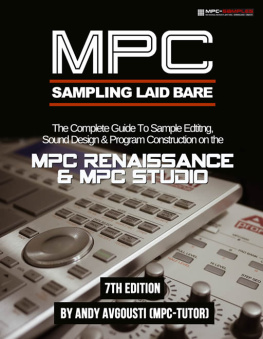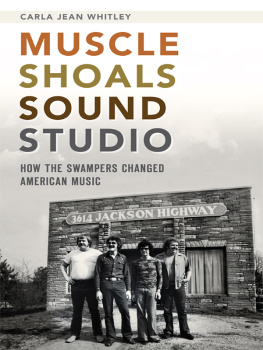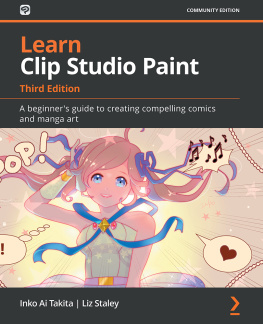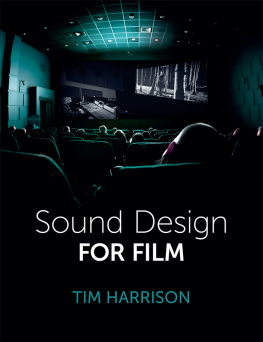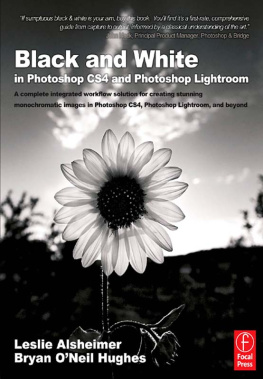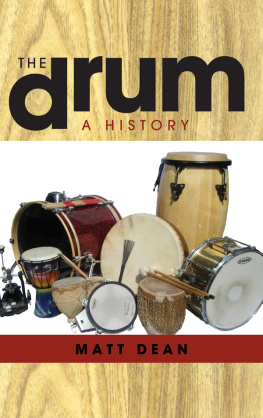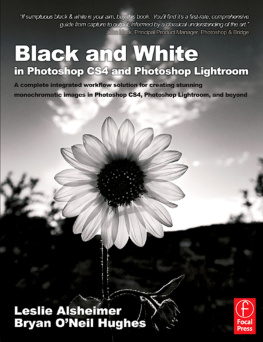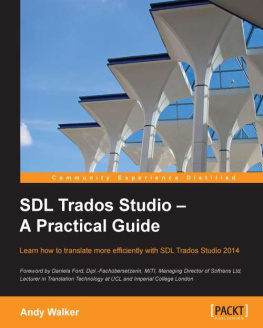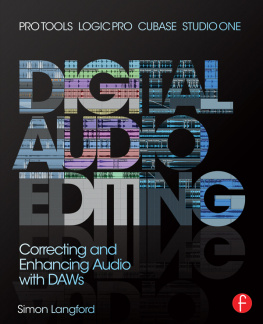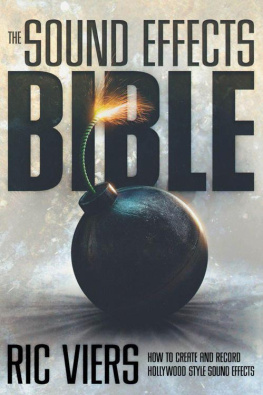The MPC Renaissance & MPC Studio: Sampling Laid Bare (6th Edition)
Written By Andy Avgousti
Copyright Andy Avgousti 2013 - 2015
First edition published by MPC-Samples.com in 2013
Sixth edition published 2015
All rights reserved. No part of this book, nor any of its associated tutorial files may be reproduced, resold, or transmitted in any form or by any means without prior written permission of the Publisher.
The Author and Publisher have made every effort to ensure the accuracy of the information herein. However, the information contained in this book is sold without warranty, either express or implied. Neither the Author nor Publisher, nor its dealers or distributors will be held liable for any damages to be caused either directly or indirectly by the instructions contained in this book, or by the software or hardware products described herein.
The Author and Publisher are not endorsed by, nor affiliated to Akai Professional LP.
MPC-Samples.com is a trading name of Beat Box Digital LTD, a company registered in England & Wales, Company No. 6810062.
Foreword
The late 1990s was a period when I found myself drawn to the exciting world of sample based music production. At the time I was unconvinced about the reliability of a computer so was looking to build a hardware based studio, but was struggling so many options available, but they all seemed too complex for my needs at that time; I just wanted to switch on and make music, I didnt want anything getting in the way of my creativity.
This all changed in 1999 when I stumbled upon a review of an MPC2000XL in Sound on Sound. It looked like the ideal solution a single, portable unit that combined a sampler and a powerful sequencer, with built in pads to let me perform everything without the need for a separate controller. And the rest, as they say, is history.
So how does the MPC Renaissance and MPC Studio change all this? Well fundamentally those features are all there with one massive difference. The MPC is now split between a separate controller (The MPC Renaissance/Studio hardware), and the MPC itself a software application installed in your computer (the MPC Software). In essence, much of the guts of the original standalone hardware MPC has been yanked out and shoved inside your computer where it is no longer constrained by the small and fixed processing power found inside a traditional hardware MPC.
In this first book dedicated to the new generation of MPCs, I wanted to focus specifically on the sample-based aspects of the MPC Software, so well be learning all there is to know about sound design, DRUM and KEYGROUP programs, sample editing, looping, chopping and along the way discovering the many practical uses of all these fantastic features including building velocity sensitive drum kits, drum layering, sound design, chopping breaks, instrument multisampling and a whole bunch of essential shortcuts, tips and thorough explanations of all the features that the official manual tends to quickly skim over.
I also want to help strike that balance between the classic hardware MPC mind-set and the modern computerfocused world, explaining how long term legacy MPC users can adapt their workflow to this different environment, while unravelling the fundamental mysteries of core MPC workflow to complete MPC newbies.
Dont worry, its going to be easy. And most importantly lots of fun!
000 How to Use this Book
Which MPCs are compatible with this book?
This book has been written to be compatible with both the MPC Renaissance and MPC Studio. They both run the sample MPC Software, so most differences are simply in the controller hardware whenever these differences become relevant to a particular tutorial, I will highlight them and carefully explain how your approach may differ in the Studio compared to the Ren (e.g. Q-Link operation).
Which version of the MPC Software should I be using?
The minimum version you should be using with this book is MPC Software 1.8.2. To check which version you have, go to Help > About MPC (in a PC) or MPC > About MPC in a Mac. From the Help/MPC menu, you can also Check For Updates to download any new updates to the software. Updating to 1.8.2 is completely free.
LCD or Computer Screen?
When working in legacy MPCs, the workflow always involved immersing yourself in the hardware screen, using the pads, dials and buttons in front of you everything you needed was there in front of you, the ultimate standalone music production box.
At the time of publication, this standalone workflow is not yet 100% possible with the Ren nor Studio as some functionality of the MPC is still only available in the MPC Software environment only. So there will be times when you are required to use your mouse and look at your computer screen. That said, the more I used the new MPCs, the more I began to realise that while that legacy-MPC mentality works incredibly well for many operations, there are some situations where it simply makes more sense to head over to your computer and take advantage of the benefits the computer environment can offer.
Within this book I will present tutorials primarily from the perspective of the hardware and hardware screen, except in the following situations:
- Where the functionality I am discussing is not available in the hardware (e.g. naming files, setting number of keygroups)
- Where the functionality is clearly easier to utilize and understand in the MPC Software environment.
Ultimately, its about using all the tools available in the most creative and workflow efficient manner.
Sequencing Requirements
Sequencing and song creation in the new generation of MPCs is a huge topic, and I wanted to dedicate some serious time working on more advanced tutorials to cover these areas; so I decided to focus purely on the sampling and program aspects in this book and will cover sequencing extensively in my next Ren/Studio book.
However I soon realised that in some sampling tutorials I really needed to introduce some basic sequencing concepts to help highlight the practical usefulness of the sampling techniques I was showcasing (e.g. chopping drum breaks etc), hence I decided to place a separate, no-nonsense guide to core sequencing basics in the appendices at the end of this book. That way you have a quick, to-the-point reference guide to sequencing basics should you need it.
Recreating the Tutorial Examples
Every tutorial in this book comes complete with all the files you need to recreate the tutorials as you read through them. All these files can be found in the Tutorial Files folder in the archive you downloaded after buying this ebook. You should copy this folder to a convenient location on your computer, such as your Desktop, Dropbox folder or an external disk. I will show you how to set up a quick shortcut to this folder in the first chapter, where well also learn how to load the files into your MPC.
If you discover any problems or bugs in the book, please let me know via and Ill get them fixed as soon as possible.
So, fire up your MPC hardware, launch the MPC app, and lets get cracking!
001 Getting Started
As I mentioned in the foreword, an MPC has always been a very powerful combination of MIDI sequencer, audio sampler and controller but lets just clarify exactly what I mean by these terms.
Before We Start
I am going to assume that you have already set up your new MPC, both in terms of the software installation and general hardware configuration and essentially are good to go. If that is not the case, dont worry, I have a step-by-step guide to this in the Appendix at the end of the book, along with some handy hints on overcoming some common installation and usage problems that you may come across!

